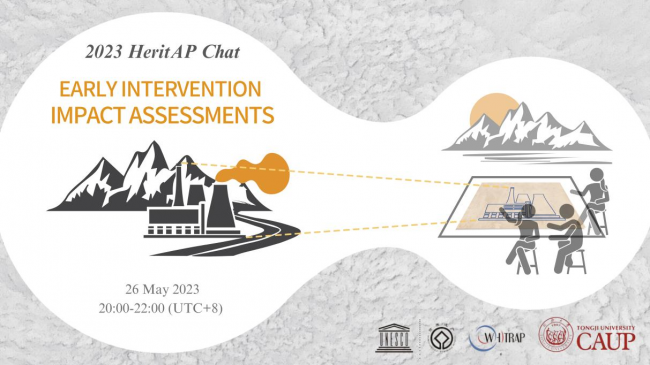| 2023 HeritAP Chat on Early Intervention of Impact Assessments |
| Author:GUAN Yi, LI Hong, WHITRAP Shan PublishDate:2023-06-08 Hits:3047 |
Event cover
On May 26, WHITRAP Shanghai organized the 3rd Online Heritage Asia and the Pacific (HeritAP) Chat on “Early Intervention of Impact Assessments”. Seven experts were invited to attend the activity, among which three cases from China, German and Canada were presented to trigger the discussion. In total 25 audiences joined the session. The activity was conducted through two parts: case presentation and free chat.
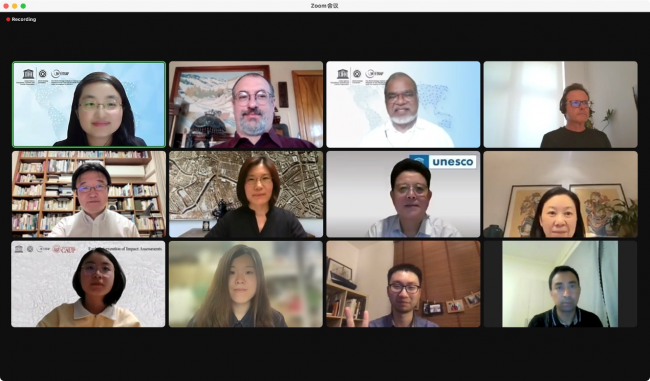 Online group photos
At the beginning, Ms. LI Hong (Programme Specialist, WHITRAP Shanghai) gave an introduction to HeritAP and the 3rd HeritAP Chat on Early Intervention of Impact Assessments. HeritAP serves as a network of heritage practitioners, groups and institutions supported by WHITRAP Shanghai. It organizes regular activities, such as Annual Meeting and HeritAP Chat on a specific topic for common issues and good practices. Based on the issue raised at the first HeritAP Chat that IA was sometimes too late, the third HeritAP Chat will rethink impact assessment in management system through three cases and an open chat.
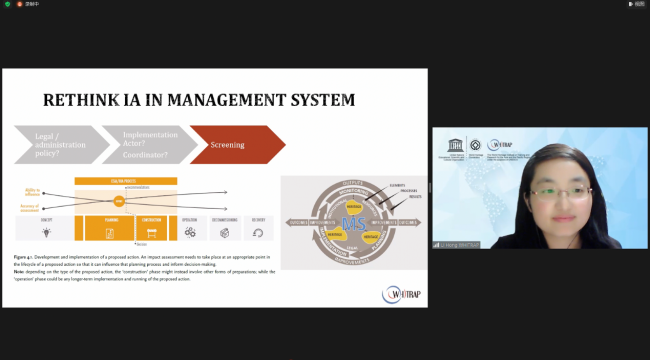 Ms. LI Hong presenting
“2023 HeritAP Chat on Early Intervention of Impact Assessments”
During the first session of case presentation, three cases from Germany, China and Canada were presented to introduce the possible early intervention from different departments and impact assessments of cultural heritage properties.
Mr. Michael KLOOS (Professor, RheinMain University, UNESCO Chair on Historic Urban Landscapes and Heritage Impact Assessments) focused on using heritage impact assessment as a pro-active instrument in urban and regional planning. He started with introduction to the implementation of World Heritage Convention and situation for impact assessments. Then he pointed out how to integrate traffic, service infrastructure and contemporary architecture is a common issue in World Heritage properties. However, the lack of embedding in legislation and interconnection with planning processes prevented HIAs being used as a pro-active instrument for World Heritage management. Taking Upper Middle Rhine Valley project as an example, he introduced systematic approaches including cartographic and photographic attribute mapping, vitural 3D model and monitoring advisory council. Mr. KLOOS concluded that HIAs need to be closely link with urban planning, natural and monumental preservation and UNESCO-World Heritage through national, regional and international law.
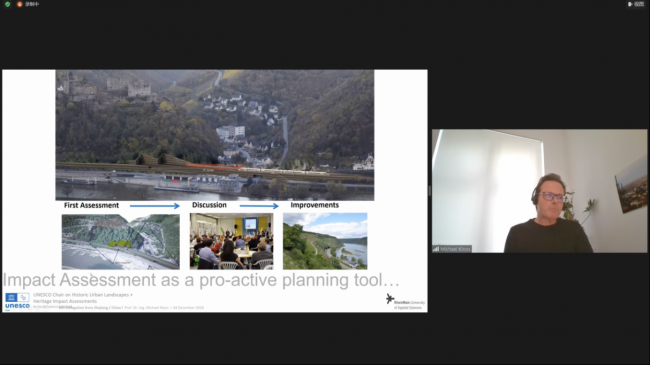 Mr. Michael KLOOS presenting
“Using Heritage Impact Assessment as a Pro-Active Instrument in Urban and Regional Planning”
Ms. KOU Huaiyun (Associate Professor, College of Architecture and Urban Planning, Tongji University) shared a case study in Wuxi City about applying HIAs in the early stage of urban regeneration in China. She first introduced three main shifts in urban regeneration and heritage conservation in China as background. Then taking Dongting hospital expansion plan in Dongjie historic district as example, the team assessed the impact of the expansion plan on the historic district from visual, traffic, historical fabric and social dimensions. Following UNESCO's HIA guidelines, they identified the district's values and attributes and conducted a qualitative analysis based on the findings. They concluded that the proposed hospital expansion would harm the functional orientation and historic environment of Dongjie historic district. Reflecting on this case, Ms. KOU pointed out that an additional step of regulatory plan adjustment is necessary after the site selection plan is decided, which presents a valuable opportunity for early intervention of HIA.
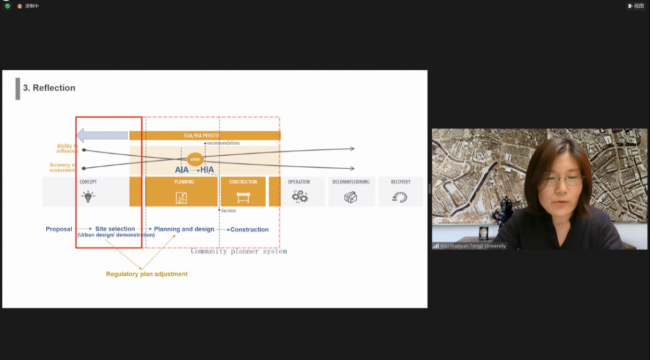 Ms. KOU Huaiyun presenting
“Applying HIAs in the Early Stage of Urban Regeneration in China: A Case Study in Wuxi City”
Mr. Marcus Réginald LETOURNEAU (Managing Principal, LHC Heritage Planning & Archaeology Inc.) presented Heritage Impact Assessments in Canada. He first pointed out that Canada is a federal state and thus each province is responsible for the management of its own heritage. Then he identified numerous problems of the HIA process in Canada through cases, such as the perception of HIA being only condition of approval and the lack of HIA requirement. Since HIA is far from enough due to the lack of regulatory enforcement, Mr. LETOURNEAU suggested the need for a conservation management plan or a temporary protection plan (TPP), which can identify potential risks to a cultural heritage and provide appropriate monitoring and guidance for constructions. The presentation concluded with a case study of an 1815 structure supplemented the point that HIA is not sufficient in protecting heritage, and more legislation on the requirements of HIA and heritage conservation process must be passed.
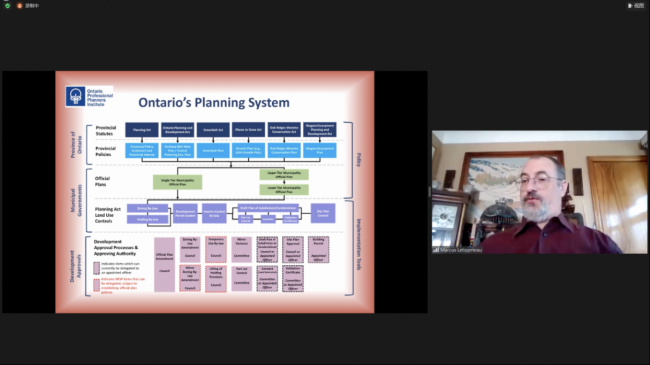 Mr. Marcus Réginald LETOURNEAU presenting
“Heritage Impact Assessments in Canada: A Reflection”
While in the second session of free chat, Mr. Gamini WIJESURIYA (Special Advisor of WHITRAP Shanghai and ICCROM) moderated and seven expert speakers deepened substantive discussions on how to improve the early intervention of impact assessments and embed them into the management system.
In terms of how World Heritage process promotes early intervention of impact assessments, Mr. JING Feng (Chief, Culture Unit, UNESCO Bangkok Office) emphasized that in the Word Heritage management system, the reaction monitoring helps the involving process of HIA. When reviewing the State of Conservation reports, Committee's concerns the reliability and timeliness of assessments for projects that may affect the property's Outstanding Universal Value. It is challenging to balance the development needs, communities’ quality life and the protection of heritage. Therefore, the dedicated tools are required to assist State Parties to fulfill their duties, such as implementing and integrating HIA into the heritage conservation process.
Then Ms. Li, Mr. JING and Mr. WIJESURIYA had a discussion on what kind of projects need to be reported to World Heritage Center. Mr. JING pointed out that there are practical examples where any project affect World Heritage OUV to be reported in line with paragraph 172 of the Operational Guideline. The site management authority is the crucial role at the site level or local level, and they have to review and assess the potential impact of the project for the property, and makes a decision to report to the Word Heritage Committee as defined in the OG. Mr. WIJESURIY added that it's very hard to define what to be sent to the WHC and for the review of advisory bodies. But the intention of the paragraph 172 is to avoid any potential negative impact to OUV and attributes.
With regard to the cooperation between different administrative levels and sectors, Ms.LI raised three questions: How to build cooperation between sectors such as planning and cultural heritage sector? How the system works from national to local level? And what are the qualifications of the impact assessments team?
Mr. Kazuhiko NISHI (Chief Senior Specialist for Cultural Properties, Office for International Cooperation on Cultural Heritages, Agency for Cultural Affairs of Japan) thought cooperating with the other sectors depends on the type of culture heritage. Historical district protection system is a kind of legal process combined from the planning sector and culture sector, where existing discussion table is already there among the planners and cultural sectors or even the local populations. As for the single site or building outside the system, it’s crucial to improve the cooperation and communication capacity of planning and culture heritage person.
Mr. LETOURNEAU pointed out that in Canada a lot of HIAs are actually being produced by consultants and larger engineering and multinational firms at the provincial or local level instead of national level. Parks Canada only oversees the areas of federal jurisdiction, which means they do occasionally comment on provincial and municipal issues, but only as a commenting agency without authority to make the decision. Review is not just a question at the national level, but at the provincial and the local level. HIA is not a mandatory part of environmental assessment or planning, causing a huge issue that no credited training to the people who develop and review the HIAs.
As for teaching, training and capacity building of HIA, Ms. KOU expressed her view based on the teaching course involved HIA with graduate students. Mr. KLOOS introduced that World Heritage is a part of study courses for bachelor and master of architectural heritage conservation, including heritage impact assessments and other courses. And the young generation are more conscious about World Heritage, which is also a great opportunity. He also appreciated that the new Guidance and Toolkit is a major concrete step forward which can be used also for education.
Mr. JING emphasized that since the Guidance and Toolkit of HIA is available, it’s very important to integrate this as part of competence framework, capacity building and training activities in the use of existing network and all the existing institutions such as the category 2 centers.
Last but not least, Ms. LI on behalf of WHITRAP Shanghai and HeritAP, appreciated the participation and discussion of all experts. WHITRAP has set the impact assessment as a priority theme program and will start further capacity building activities, not only training but also some pilots research and guidelines from local level to the national level, to better facilitate the communication among professionals and respond to management and conservation of the sites.
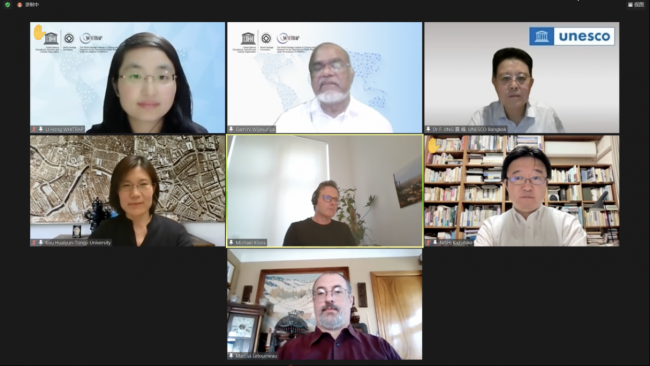 Participants’ chat
Contributed by Guan Yi、 Li Hong
Edited by Li Jiahui (Intern) Typeset by Kong Xiangmeng (Intern) |
- SEAMEO SPAFA-WHITRAP Training Workshop on Heritage Impact Assessment held in Melaka
- Call for Application | 2024 Global Awards for World Heritage Education Innovative Cases(AWHEIC) Promoting what people do and how they do it
- Documentary: 2023 World Heritage Creative X Innovators Conference and the AWHEIC Third Anniversary Celebration
- Publication | WHITRAP Newsletter No. 61
- Mt. Huangshan first show in Climate Action for World Heritage
- Call for Good Practices: 2024 Environment and Resilience
Copyright © 2009-2012 World Heritage Institute of Training and Research-Asia and Pacific (shanghai)


